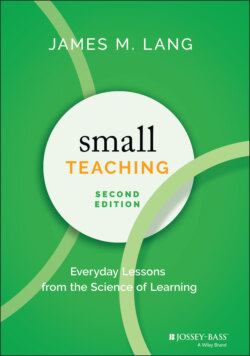Читать книгу Small Teaching - James M. Lang - Страница 20
CONCLUSION
ОглавлениеAs I was finishing the second edition of this book, an article appeared in a psychology journal which provided another plank of support for the power of prediction, as well as one more reason why prediction has such a positive impact (Brod 2021). The article describes an experiment in which the researchers asked students to predict the scores of a soccer game, then revealed the correct scores to them, and afterward tested their memory of those scores. But they compared the students who engaged in these predictive activities to another group of students who did something slightly different: they were shown the correct scores, and then asked to explain whether those scores matched their expectations about them. In other words, the students in that second group were essentially being asked: If you had made a prediction, would it have been correct? As you might expect from the research I have provided throughout this chapter, the students who made the actual predictions had better memory for the soccer games than did the students who only reflected afterward upon how well the scores matched their expectations. The concrete act of making the prediction was the crucial differentiator: they had to use their prior knowledge of soccer to hazard a prediction, and then see the results afterward.
The researchers in this study added one interesting element to their experiment, though. They looked at the pupil dilation of the subjects as the answer was revealed to them. When the subjects who had made predictions saw the correct answers, their pupils dilated, indicating surprise. The researchers thus argue that one of the driving mechanisms behind the learning power of prediction is the quick emotional burst we get from seeing how our prediction turns out. As we shall discuss further in Chapter Eight, emotions can play a key role in enhancing our learning. In this experiment, the predictions that the subjects made about the soccer games heightened their emotional investment in finding out the scores, and this emotional investment paid dividends in their learning. This finding on the emotional impact of prediction led the researchers to conclude that random guessing doesn't have the same impact as prediction. When I make a random guess, I'm aware of its randomness, and don't make an emotional commitment to it. When I make a prediction, I'm drawing on my prior knowledge to try to understand a novel situation, and as a result I become more emotionally invested in the outcome: I want to know if I was right. It's that emotional investment, the researchers argue, that makes the difference, and that helps lodge the new knowledge firmly in my brain.
Keep this finding in mind as you are engineering predictive activities for your students. If you give them a pretest, encourage them to draw on their previous knowledge to try and get as many correct as possible. If you are asking students to predict something in class with electronic polling, actually give them the time they would need to think about it and make that prediction. The more they commit themselves to their predictions, the more emotion they will feel at the revelation of the correct answer—and the more they are likely to remember it in the future.
